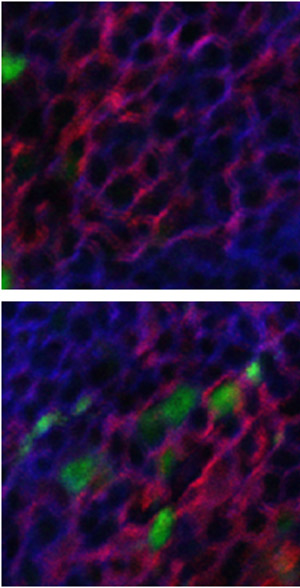Sep. 3, 2010 Research Highlight Biology
Ready and waiting
A subset of immune cells remain ideally positioned to respond quickly to the reappearance of previously encountered pathogens
 Figure 1: A fluorescent indicator of cell division (green) reveals that IgG memory B cells (purple) are largely quiescent during an initial antigen challenge (top), but undergo activation and proliferation in response to a secondary challenge (bottom). Reproduced from Ref. 1 © 2010 National Academy of Sciences, USA
Figure 1: A fluorescent indicator of cell division (green) reveals that IgG memory B cells (purple) are largely quiescent during an initial antigen challenge (top), but undergo activation and proliferation in response to a secondary challenge (bottom). Reproduced from Ref. 1 © 2010 National Academy of Sciences, USA
Like a burglar tripping an alarm, infectious threats within the body set off a chain reaction of signaling events that enable the immune system to mount a proper defensive response. Once the crisis is averted, populations of target-specific ‘memory’ B cells ensure that any return visit by the same pathogen will be dealt with promptly and harshly.
Memory B cells initially arise within germinal centers in spleen lymph nodes, but it has proven challenging to determine whether they continue to reside there or circulate throughout the body. By applying sophisticated cellular imaging techniques, a team led by Tomohiro Kurosaki of the RIKEN Center for Allergy and Immunology in Yokohama has now resolved this question for at least one major subset of these cells1.
B cells are primarily categorized based on the immunoglobulin protein chains they incorporate into their antibodies, and Kurosaki’s team primarily focused their attention on immunoglobulin G-expressing (IgG+) cells. Using a variety of fluorescent labeling strategies, they were able to determine that IgG+ memory cells remain clustered close to the germinal centers long after the initial immune response in mice injected with the immunostimulatory molecule nitrophenol. By comparison, immunoglobulin M-expressing (IgM+) memory cells are found scattered at discrete sites throughout the spleen.
Subsequent experiments with a fluorescent indicator of cell division showed that IgG+ cells replicate rapidly in response to a secondary challenge with nitrophenol (Fig. 1), and that this process is dependent on direct interaction with helper T cells, which are also located in close proximity to germinal centers. The communication between these two cell types appears to directly contribute to elevated production of antigen-specific antibodies. “Although preliminary, our data suggest that IgG+ memory B cells are more prone to differentiate into antibody-producing plasma cells than IgM+ memory B cells, which may contribute to regeneration of the memory pool after a secondary antigen challenge,” says Kurosaki.
The memory cell-mediated immune response is generally faster and more robust with regard to target recognition than the ‘first encounter’ with a given pathogen, and Kurosaki believes that these findings represent an important step toward understanding the efficiency of the memory cell response. “Before our study, people believed that memory B cells leave the germinal centers and are recirculated all over the body by the lymphatic system and blood,” he says. “However, our study clearly demonstrates that some IgG—but not IgM—memory B cells reside continuously near germinal centers and thus [enable] rapid activation after antigen re-challenging.”
References
- 1. Aiba, Y., Kometani, K., Hamadate, M., Moriyama, S., Sakaue-Sawano, A., Tomura, M., Luche, H., Fehling, H.J., Casellas, R., Kanagawa, O. et al. Preferential localization of IgG memory B cells adjacent to contracted germinal centers. Proceedings of the National Academy of Sciences USA 107, 12192–12197 (2010). doi: 10.1073/pnas.1005443107
